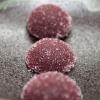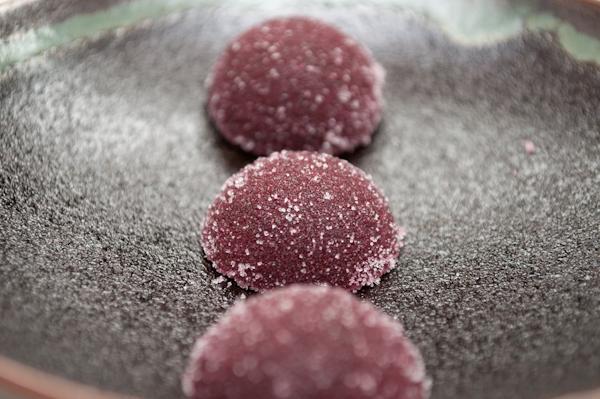-
Posts
1,890 -
Joined
-
Last visited
Content Type
Profiles
Forums
Store
Help Articles
Everything posted by mkayahara
-

Next (restaurant) e-book series by Grant Achatz
mkayahara replied to a topic in Cookbooks & References
Meaning what? -
I've done an orange-and-clove pâte de fruit the past couple of years at Christmas, and it works great using pure clove oil. But if he really wants something with the texture of a gummy bear, I would think gelatin would be the best place to start. Aren't gummy bears basically just sugar, gelatin and flavouring anyway? That way, he wouldn't have to worry about finding a neutral base.
-

Next (restaurant) e-book series by Grant Achatz
mkayahara replied to a topic in Cookbooks & References
The full version has no greyed-out areas; I imagine that's what makes it a sample. Page turning can be slow (and, to my mind, is counterintuitive), but I have no other books to compare to. I've managed to make a recipe out of the Paris 1906 book on only my iPhone, so I have no complaints. (Admittedly, it was a short recipe.) -
I don't understand why you would use paper towels instead of coffee filters, or a sieve and cheesecloth if you wanted the process to be faster. Not that I think paper towels are likely to harm you, I just don't think they'd be very good at filtering. As far as chemicals used to manufacture and bleach them, I suspect they're no worse than the chemicals used to manufacture and bleach coffee filters.
-
Thanks! Yes, it was a silicone mold. This one, to be precise. I liked how they came out. The recipe suggests transferring the cooked base to a smaller container to portion into the molds, and it worked great.
-
Recently made the beet pâte de fruit from the Next Restaurant Paris 1906 e-book. (Not the recipes from the Fat Duck or Noma... how many beet PDF recipes do I have, anyway!?) I had read in the Fat Duck book that when you add enough acid to beet, it starts to taste like blackcurrant, and it was cool to be able to experience that effect while it was cooking. With the citric acid in the recipe, it really did smell like blackcurrant! It definitely comes out tasting like beet, though, especially after a couple of days. Personally, I like it.
-
Coincidentally, that's exactly what I'm getting, as a combined Christmas and birthday gift. My husband is apparently in a generous mood this year.
-
I finally got around to trying this technique, and in a "run before you walk" moment, tried to develop my own recipe. Mostly because I wanted red velvet cake. It seemed to work, though I don't have much to compare it to, never having tried any of the professional recipes out there that I used as inspiratoin for my own. The colour and flavour were good, but it didn't rise as much as I thought it would, and I experienced some of the hardening discussed upthread. I would certainly welcome any input on my formulation. I served it with a beet fluid gel, cream cheese icing and candied pecans. 100g egg whites 70g egg yolk 80g sugar 20g all-purpose flour 5g cocoa powder Pinch salt 60g butter, melted 60g buttermilk Red food colouring, in paste form, as desired
-
Pages 128-129 are the continuation of the Black Bass recipe on 127.
-
As they should. Transporting liquid nitrogen in any other container is just asking for trouble.
-
I wouldn't let that stop you. You can't substitute for it, but there are still lots of other fascinating drinks in the book, not to mention the narrative itself. And it's not like it's a big outlay. Plus, who knows? I hear the LCBO has some surprises up their sleeve for the coming year, so they may yet bring some in.
-
If you have a deep-fryer, you could do some sort of puffed snack, too. I think that's a pretty cool technique (if time-consuming), and it should play well if the crowd is already familiar with pork rinds.
-
Foams and airs as always good for a laugh, if you have a foam siphon and/or lecithin. If you have a vacuum chamber (or canisters and a FoodSaver), you could do aerated vacuum-set chocolate, which I thought was pretty cool. Also, depending on what kind of gear you have, and how "food science-y" you want to get, slow-cooked eggs are pretty neat for demoing protein coagulation. Are you looking to do "tricks" or actual exploration of the physical and chemical properties of food?
-
I'm not sure I understand this argument... isn't osmosis just diffusion across a membrane? So is he saying that there are no membranes in meat, or that that's not where the salt goes?
-
The other night, I made a variation on the Boomerang from the Savoy. Its original incarnation is equal parts dry vermouth, Swedish punch and "Canadian Club Whisky," with a dash each of lemon juice and Angostura. I didn't have any dry vermouth open, but I did have dry sherry. (I like to minimize the number of fortified wines I have open at any given time.) So it turned out something like this: 1 oz. bourbon (Four Roses) 1 oz. fino sherry (Tio Pepe) 1 oz. Swedish punch (homemade) dash Angostura I thought it was certainly interesting, but I'm still not sure it was necessarily good.
-
Really? No updates since April? C'mon, people!
-
Conversely, why should I have to pay more for my dinner because you failed to show? I never pull a no-show if I can help it, and if there's an emergency that makes it unavoidable, then I accept the cancellation charge as part of the cost of the emergency. Of course, this is just like the tipping discussion; we're never going to get everyone to agree that one approach is the best.
-
Funny how our collections break down, isn't it? When I went through mine, I realized I have only 7 books devoted to pastry/baking/confectionery: two books on frozen desserts, two books on confectionery, two Anna Olson books, and I <3 Macarons. They must count for at least one book collectively! Whenever I show my friends an issue of Art Culinaire and refer to it as a "magazine," there's this look they give me...
-

Traditional departments in a French brigade kitchen
mkayahara replied to a topic in Food Traditions & Culture
Thanks! Is there actually a section in Escoffier where it's broken down like that? Or did you simply interpolate from other information? I like the idea of corndoggier, and I think we should adopt aboyeur in English: call it "barker" instead of "expediter." -
So I hear the second issue is out... has anyone picked it up yet?
-
In a recent rearrangement (and expansion) of the bookshelves devoted to my cookbooks and cocktail books, I took the opportunity to count them. The total came in at around 170. (Of course, that's not counting "food literature" or magazines.) When my bookstore finally gets off its butt and brings in a copy of the Eleven Madison Park cookbook that's not damaged, it'll be 171.
-

Traditional departments in a French brigade kitchen
mkayahara replied to a topic in Food Traditions & Culture
The problem with that Wikipedia article is that it doesn't distinguish between what's a rank and what's a department. I wasn't actually sure whether tournant, for example, was counted as one of these putative "nine traditional departments." Based on that list, though, I wonder if the position missing from Edward J's list is butcher. -
While reading a cookbook recently, I came across a reference to "the nine traditional departments" in the French kitchen, all "run by independent sous-chefs - from the saucier to the rôtisseur." I sat down and tried, but couldn't think of all nine departments, and none of my books seem to list them as such. Could anyone tell me what they are? Or are there more/less than nine?
-
Enjoying a really delicious Aston Martin from the May/June 2011 Imbibe Magazine: 1.5 oz. dry sherry (Tio Pepe fino) 0.75 oz. London dry gin 0.5 oz. Benedictine Stir, strain, up, lemon twist. What this is pointing out to me is that I don't drink nearly enough sherry...
-
I don't have a direct answer to your question, and I'm assuming you're looking for information that's more detailed than what's available in a book like The Flavor Bible or a website like http://www.foodpairing.com/. What I would recommend is that you contact Martin at khymos.org. He should at least be able to let you know whether a resource like you're searching for exists. Good luck!



